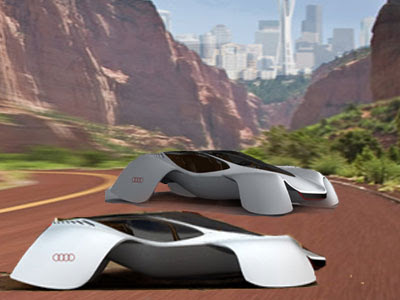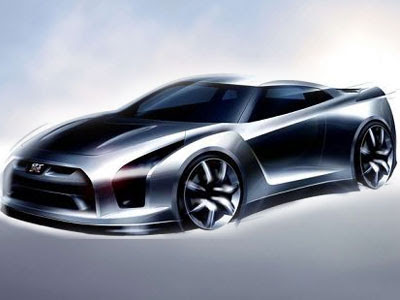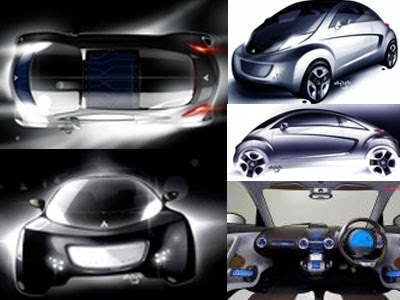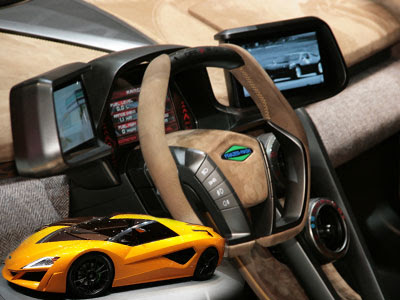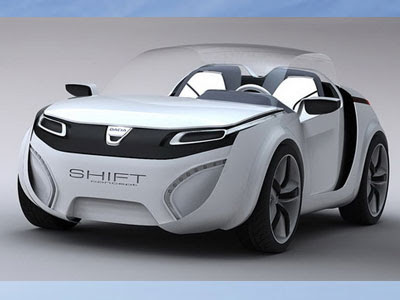The steering wheel has been replaced with what looks like a flight yoke. The rear view mirrors have been replaced by cameras and monitors. The dashboard definitely looks like it belongs on a vehicle of the future.
The Land Glider has a potential to become a new means of transportation in urban areas; its linear acceleration and the narrow body, which only an ultra-compact, ultra lightweight EV can achieve, will help reduce traffic congestion and promote effective use of parking space.
Shift of the center of gravity by leaning provides a new, exciting sense of driving and a powerful, crisp ride.

Nissan Land Glider Concept
Nissan's planning and design team were given a challenge: to explore new forms of zero emissions mobility that redefined existing segments. The result was a radical new vehicle that combines the company's vision for future urban mobility with
Nissan's great driving heritage.
In creating the
Land Glider concept, Nissan planners and designers have conceived a totally new form of personal zero-emissions mobility that combines clever, new driving experiences, all in the one compact, 4-wheeled package.
With more than 50% of the world's population living in big cities in the near future, designers latched onto motorcycles as a credible base to start the design process.
While the agility, thrills and freedom of
bikes inspired the designers and engineers, an extra spice was added to the mix. Tandem architecture became the obvious choice. A unique two-seater, cocoon-like structure sitting on a zero emission powertrain. With fourwheel stability and a sense of safety that originates from a tilting cabin, the
Land Glider will appeal to both two- and four-wheel driving enthusiasts.
Targeted at city dwellers of all generations, the
Land Glider is a serious motoring statement of the new era of mobility that
Nissan intends to lead.
Cocoon in the Shell"The exterior incorporates a soft, sleek-looking body that appears to be protected by a special armor," explains
Takashi Nakajima,
Nissan's Project Design Director. "And while it is very mechanical in its nature, the four-wheeler boasts a dynamic body design that almost seems alive. As part of Nissan's expanding zero emission family, the
Land Glider exudes a clean, friendly attitude."

Nissan Land Glider Concept
The vehicle's two-seater tandem layout is enveloped in what seems like the canopy of a glider, while its unique ‘tilt' setup employs a special leaning function that holds occupants firmly in place even when the vehicle is cornering at angles. In developing the Land Glider, Nissan designers have created a two-seater that offers the sense of security of a cocoon, but delivers real driving pleasure.
Described as a ‘personal city commuter,' the Land Glider features steering-by-wire and a lean capability when cornering - like a motorcycle - that enables the vehicle and its tires to lean by up to 17 degrees. Able to turn sharply at nearly any speed, the Land Glider employs sensors for vehicle speed, steering angle and yaw rate to instantly calculate the level of lean required to negotiate a corner. All the driver must do is turn and the cabin will lean accordingly. By enabling the car to lean, designers have succeeded in minimizing vehicle width and tire tread width, thus achieving a sleek, futuristic look.
With drive coming from two electric motors in the rear powered by lithium-ion batteries mounted beneath the floor, the zero-emissions Land Glider is quick off the mark. The car also features a non-contact charging system that can be charged whilst shopping at a supermarket or stopping at a motorway service station. This system enables vehicles to be charged wirelessly at locations where the infrastructure exists.
To ensure maximum safety whilst driving, engineers have fitted a car-robotics style crash avoidance system in which sensors mounted in the body detect other vehicles in the same way as fish swim in schools without colliding. This system directs the vehicle's path away from any obstacles.*
Whilst Land Glider is a concept car created for the Tokyo Motor Show. It should not be regarded as a mere design study. This leaning machine gives a clear direction to how a future small car from Nissan could look in congested cities...a clue of what Nissan means by new era of mobility.


